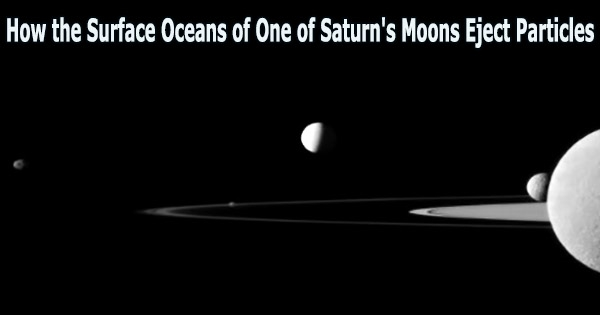Enceladus, the sixth biggest of Saturn’s 83 moons, has long been regarded by astronomers as one of the more intriguing bodies in our solar system, despite its modest size.
Because of how it appears and behaves, Enceladus differs from other celestial bodies. The brightest and whitest surface ever seen by astronomers can be found on it. And it’s known for spraying out tiny icy silica particles so many of them that the particles are an important component of the second outermost ring around Saturn, its so-called E ring.
Enceladus is characterized as an “ocean world,” a celestial body with a substantial volume of liquid water. Yet, unlike oceans on Earth, which are found on the surface of the planet, Enceladus’ ocean is shielded by a substantial amount of ice. The ocean isn’t entirely contained by the ice, though; enormous cracks in the ice known as “tiger stripes” allow some materials from the wet region to escape toward Enceladus’ warmer south pole.
The silica particles that Enceladus ejects begin their journey at the sea floor, far beneath the moon’s surface, and to date, scientists have not known how that happens or how long the process takes.
A new study led by UCLA scientists offers some answers. According to the findings, the silica is likely generated by deep-sea hydrothermal vents over the course of just a few months and is then transported by currents that are created by tidal heating in the rocky core of Enceladus.
The research was published in Communications Earth & Environment.
Ashley Schoenfeld, a UCLA doctoral student in planetary science, led a group that analyzed data about Enceladus’ orbit, ocean, and geology that had been collected by NASA’s Cassini spacecraft. The scientists constructed a theoretical model that could account for the silica’s transport across the ocean.
Our research shows that these flows are strong enough to pick up materials from the seafloor and bring them to the ice shell that separates the ocean from the vacuum of space. The tiger-stripe fractures that cut through the ice shell into this subsurface ocean can act as direct conduits for captured materials to be flung into space. Enceladus is giving us free samples of what’s hidden deep below.
Ashley Schoenfeld
Enceladus’ active geology is fueled by tidal forces as it orbits Saturn the moon is tugged and squished by gravity. The new model showed that friction heats the ocean’s bottom to the point where a current moves the silica particles toward the surface of the water. This deformation causes friction in both the moon’s ice cover and its deep rocky core.
“Our research shows that these flows are strong enough to pick up materials from the seafloor and bring them to the ice shell that separates the ocean from the vacuum of space,” Schoenfeld said. “The tiger-stripe fractures that cut through the ice shell into this subsurface ocean can act as direct conduits for captured materials to be flung into space. Enceladus is giving us free samples of what’s hidden deep below.”
Cassini found substantial amounts of hydrogen gas in the plumes which, together with the silica, present compelling evidence for hydrothermal activity at the ocean floor. The theoretical model developed by the UCLA-led team supports that idea by outlining a likely timescale for the process and a solid mechanism that would account for why the silica-containing plumes exist. The silica particles are brought to the surface along with other components, which the model would also help to explain.
“Our model provides further support to the idea that convective turbulence in the ocean efficiently transports vital nutrients from the seafloor to ice shell,” said second author Emily Hawkins, a UCLA alumna who is now an assistant professor of physics at Loyola Marymount University.
On Earth, similar deep-sea hydrothermal vents harbor a multitude of fascinating organisms that feast on minerals the vents release.
Further data could be gathered by spacecraft in the future, allowing researchers to better understand the physical and chemical characteristics of Enceladus’ probable hydrothermal vent systems.
The current study provides some information that should help the search for those biosignatures. In order to assess if those vents may support life, scientists would need to test the plumes for chemical evidence of biological activity, known as biosignatures.
NASA’s plans for the next decade include missions that would fly by, orbit, and land on Enceladus to gather more information. The UCLA-led team plans to develop additional modeling that could help shape plans for those missions.
The paper’s other authors include Krista Soderlund and Erin Leonard, both UCLA alumnae who are now research scientists at the University of Texas, Austin, and Jet Propulsion Laboratory, respectively. The National Science Foundation funded the research.





